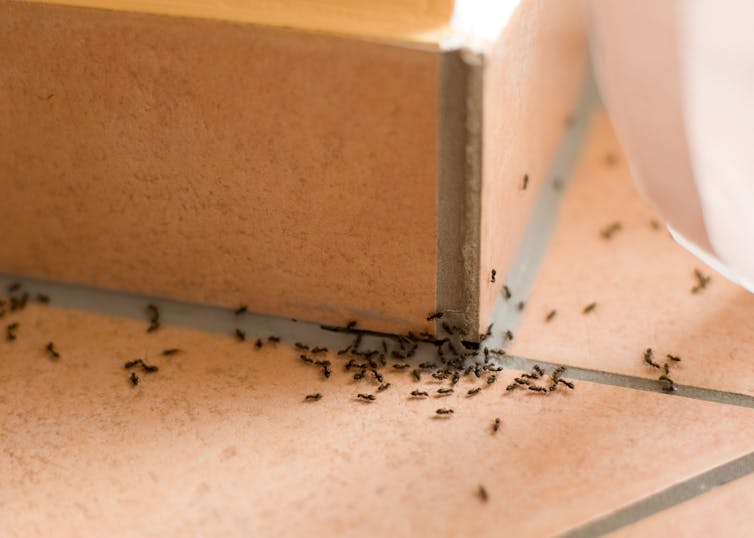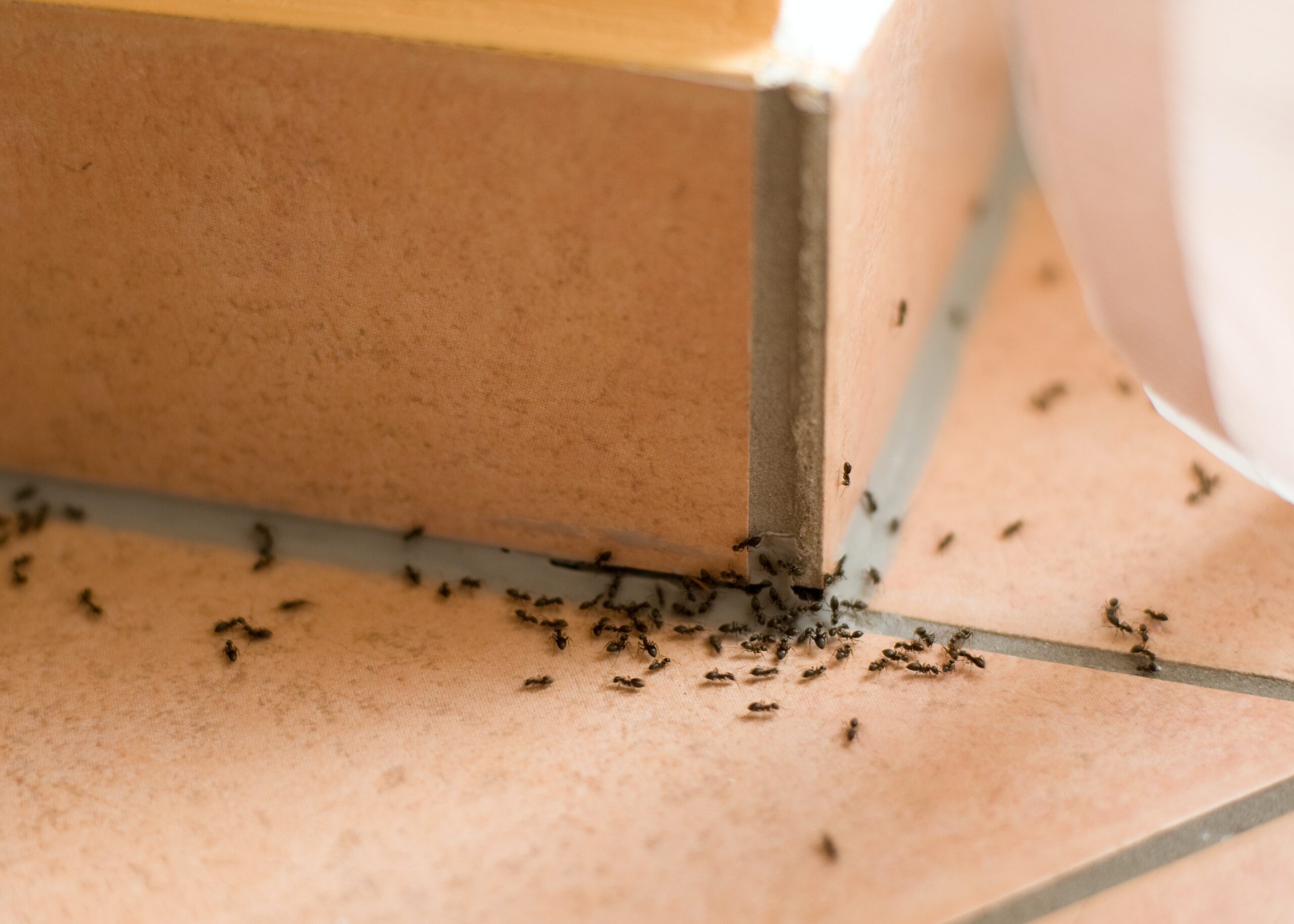I Have Ants In My House
Ants are part of nature’s cleaning crew: they efficiently find and remove food left around the house. The problem is, sometimes humans don’t want their help.
You’ve probably noticed ants more commonly come indoors in summer – that’s largely because most insects are more active in the warmer months.
Ants occasionally come inside in search of water, particularly during dry periods. In this case you may see them in bathrooms or other humid parts of the house.
Heavy rains can also cause ant nests to flood and force them to relocate to nearby buildings, such as your house.

Masters of cooperation
Ants are social animals and live in colonies with hundreds, or even millions, of others. They have tiny brains – in many cases smaller than a grain of sand. So how are they so clever at getting into our homes and finding our food? Because they are masters of cooperation.
Read more: Here’s what that house proud mouse was doing – plus five other animals who take cleaning seriously
Consider the way some ants march in a line towards that drop of honey on your kitchen bench. When worker ants of some species find a tasty piece of food, they respond by placing a tiny droplet of pheromone on the ground. They continue to leave a trail of pheromones all the way back to the nest.
Only one ant needs to find the food and lay a trail. Once that happens, hundreds of others can follow the trail to the food source.
How do I get rid of ants?
The first step to dealing with ants in your house is ensuring they don’t have access to food. Seal all food in airtight containers, clean behind the fridge and in the toaster, do not leave pet food out longer than necessary, ensure your bins are tightly sealed, and generally make sure there is no food around to entice ants (I know, easier said than done).
If you’ve seen ants marching in a line, try wiping down the surface with vinegar or bleach to disrupt the chemical trail.
Read more: Zombie ants: meet the parasitic fungi that take control of living insects
Prevent ants from entering your home in the first place by sealing up cracks and holes in walls. This will also prevent them from nesting inside wall cavities.
If all else fails, insecticidal baits can be used to control ant numbers. But before you take that route, ask yourself whether the ants are actually a problem (more on that later).
Insecticides may harm other insects
If your ant problem has got out of hand, contact a pest control professional rather than attempting to deploy a bug bomb or similar insect spray yourself.
DIY methods rarely work because ants mostly live in protected spaces (such as underground or in walls). You might kill a few worker ants, but probably won’t harm the colony.

If you (or a professional) do use insecticides, avoid using them outdoors and look for ones specifically designed for ants. Most insecticides are broad spectrum chemicals that can kill other types of insects. This includes insects beneficial in your home and garden, such as ladybirds, mantises and parasitoid wasps.
It may take a while for the ant colony to die, especially if it is large. Some species distribute themselves among several nests which makes them much harder to eradicate.
Ants fight back
In most ant species, the queen is the only individual who can produce new workers. So to destroy the colony, you need to kill the queen.
But some species, such as the rock ant (Temnothorax albipennis), have evolved an ingenious way to protect the queen and her larvae from poisoned food.
Read more: These ants have evolved a complex system of battlefield triage and rescue
Some worker ants stay in the colony and receive new food from forager ants – storing the food in their abdomen and regurgitating it when their nestmates are hungry. Since these “storage ants” collect and mix food from many workers, they help ensure that incoming poisons are diluted before they reach the queen. They also act as poison testers: if the food is toxic, they die before they can pass it on to the queen.
We need ants
Remember that ants can be beneficial predators – I’ve seen ants attack and kill cockroach nymphs. Ants also play an important role in spreading the seeds of native plants, and of removing waste from our environment.
Ants are a normal and important part of our urban ecosystems. So if we want to protect our precious biodiversity, this may mean tolerating our tiny neighbours – even when they seem intent on taking over our kitchen or ruining our picnic.
No one wants ants ruining their food. But if you have a small number of ants wandering around the house, is that really a big deal?
I Have Ants In My House
If you’re experiencing ants in your house, you may be wondering how to get rid of them. Ants can be bothersome and make your home uncomfortable. They can also be dangerous if they come into contact with food.
Ants are attracted to sweet foods and protein-rich foods. They feed on these types of foods to give them energy for their activities such as building nests, mating and reproducing. If you have ants in your home, there are some easy steps that you can take to eliminate them.
One of the first things that you need to do is find out where the ants are coming from. You can do this by looking under appliances like stoves or refrigerators for small black specks that resemble dirt but is actually dried ant feces (called “frass”). If there are no frass around, then this means that there are no more ants in your home and it’s safe for people to return after cleaning up all traces of the infestation using a vacuum cleaner or wet mop (depending on how much debris needs removing).
List Of I Have Ants In My House
- Attracts & Kills – Kills common household ants including acrobat, crazy, ghost, little black, odorous house, pavement, and other sweet-eating ants
- Kills the Ants You See & the Ones You Don’t – As worker ants discover the bait, they share it with the rest of the colony to eliminate them all
- Works Fast – You should see a significant decrease in the number of ants visiting the bait stations within just a few days
- Ready to Use – Place the bait stations, watch it attract ants, and eliminate the entire colony
- Use Throughout Your Home – Place stations near areas where you’ve seen ant activity including along baseboards, in corners, on counters, and more
Additional Info :
| Item Dimensions | |
| Height | 4.5 Inches |
| Width | 6.6 Inches |
| Length | 1.2 Inches |
| Weight | 0.27 Pounds |
- Ortho Home Defense Insect Killer for Indoor & Perimeter2 with Comfort Wand kills ants, cockroaches, spiders, fleas, ticks and other listed bugs; the formula is odor free, won’t stain, and keeps listed bugs out
- KILLS BUGS INSIDE: Kills those annoying home-invading insects, including ants, cockroaches, spiders, fleas, ticks, scorpions, beetles, silverfish, centipedes and millipedes
- KEEPS BUGS OUTSIDE: Creates a bug barrier that will kill bugs you have and prevents new bugs for up to 12 months (applies to ants, roaches and spiders indoors on non-porous surfaces)
- NO STAINING OR STINK: This spray can be used indoors and out, leaves no residue, and has no odor; people and pets may re-enter treated areas after spray has dried
- WAND MAKES APPLICATION EASY: The Comfort Wand eliminates hand fatigue, and there’s no pumping required, making it easy to spray along your home’s perimeter–indoors and outside
Additional Info :
| Color | White |
| Item Dimensions | |
| Height | 4.88 Inches |
| Width | 12 Inches |
| Length | 8.95 Inches |
| Weight | 0.73 Pounds |
Additional Info :
| Release Date | 2008-06-17T00:00:00.000Z |
- Safe
- Extra Concentrated for Long-Lasting Protection
- Natural Ingredients Proven Effective in the Real World
- Large 16oz Bottle
- Powerful Essential Oil
Additional Info :
| Item Dimensions | |
| Weight | 1 Pounds |
- Works Fast – This fast-acting traps eliminate fruit fly infestations. You should notice a dramatic decrease in fruit fly populations within a few days
- Long-Lasting Lure – The ready-to-use, non-staining lure attracts adult fruit flies. Each trap lasts up to 45 days, giving you up to 90 days of protection!
- Discreet Design – The attractive, apple-shaped trap design will look at home in any kitchen. It also blends in with the fruit these pests love
- Monitor Catches – Each fruit fly trap has a built-in window, allowing you to easily keep an eye on catches and lure levels
- Locate Breeding Areas – These traps are most effective when placed near fruit fly breeding areas, including near fruit bowls, trash cans, on kitchen counters and sinks, and other locations where fruit is stored
Additional Info :
| Item Dimensions | |
| Height | 8.38 Inches |
| Width | 10.25 Inches |
| Length | 12.25 Inches |





